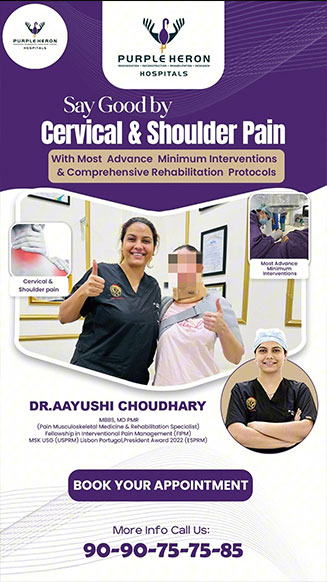Image-Guided Minimum Interventions for Shoulder Pain
At Purple Heron Hospital, Dr. Aayushi employs a cutting-edge, image-guided, minimally invasive approach to manage shoulder pain.
This comprehensive protocol integrates the latest advancements in regenerative medicine, nerve blocks, and other targeted interventions to address the diverse causes of shoulder pain, ensuring precise treatment and promoting long-term healing. Here’s an overview of these advanced interventions:
1. Image-Guided Intra-Articular Interventions
Intra-Articular Blocks: Utilizing advanced imaging techniques such as ultrasound or fluoroscopy, intra-articular blocks deliver therapeutic agents directly into the shoulder joint. This approach is particularly effective for conditions like glenohumeral osteoarthritis and adhesive capsulitis (frozen shoulder), helping to reduce inflammation and pain, improve mobility, and potentially delay the need for surgical intervention.
Intra-Articular Viscosupplementation: This procedure involves injecting hyaluronic acid into the shoulder joint under ultrasound guidance. It serves as a lubricant and shock absorber, providing significant relief for patients with osteoarthritis by enhancing joint function and reducing pain.
2. Image-Guided Nerve Blocks
Suprascapular Nerve Block: This intervention targets the suprascapular nerve, a common source of shoulder pain in cases of rotator cuff injuries and shoulder arthritis. Guided by ultrasound, this nerve block provides precise and effective pain relief.
Cervical Plexus Block: Ideal for shoulder pain that radiates from the neck, such as in cervical radiculopathy, this block targets cervical nerves contributing to shoulder discomfort.
Interscalene Brachial Plexus Block: Often used for postoperative pain management or severe shoulder pain, this block addresses the brachial plexus nerves under ultrasound guidance, offering extensive pain relief.
3. Image-Guided Hydrodissection
Hydro dissection: This minimally invasive technique is used to treat nerve entrapments and adhesions around shoulder tendons, particularly effective in cases of adhesive capsulitis and rotator cuff tendinitis. Guided by ultrasound, hydro dissection helps to free nerves or tendons from surrounding tissues, alleviating pain and restoring mobility.
4. Image-Guided Regenerative Medicine Protocols
Prolotherapy: This regenerative treatment involves the injection of a proliferant solution into damaged shoulder tendons or ligaments to stimulate healing. Under ultrasound guidance, prolotherapy effectively addresses conditions like chronic tendinopathy and partial rotator cuff tears, promoting tissue regeneration and pain relief.
Growth Factor Concentrate (GFC) Therapy: GFC therapy uses concentrated growth factors derived from the patient’s blood to enhance tissue healing. Whether administered intra-articularly or intratendinously, GFC is particularly beneficial for treating rotator cuff tears and labral injuries.
Stem Cell Therapy: Stem cells, sourced from the patient’s bone marrow or adipose tissue, are injected into the shoulder joint or tendons to promote the regeneration of damaged cartilage and other tissues. This therapy is highly effective for conditions such as osteoarthritis and rotator cuff injuries.
5. Management of Shoulder Effusions and Calcifications
Ultrasound-Guided Shoulder Joint Aspiration: This procedure removes excess fluid from the shoulder joint to relieve pain and improve function, particularly useful in cases of inflammatory arthritis or injury-related fluid buildup.
Calcific Tendinitis Treatment: Ultrasound guidance is used to dissolve calcium deposits in the shoulder tendons, a common source of severe pain, restoring mobility and reducing discomfort.
6. High-Volume Image-Guided Injection (HVIGI)
HVIGI for Tendinopathy: This technique involves the injection of a large volume of saline solution around the affected shoulder tendon to break down adhesions and scar tissue, promoting healing and reducing pain. Image guidance ensures precise delivery, making it highly effective for chronic shoulder tendinopathy.










